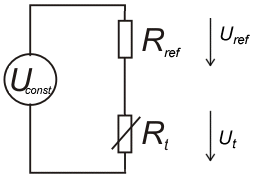Measuring principle of a resistance sensor
The resistance sensor (RTD element) is normally evaluated by measuring the voltage drop across the sensor through which a measuring current flows. The voltage change ΔUt measured in the EL3204-0162 is proportional to the resistance change ΔRt.
In the ratiometric measurement, a constant voltage is applied to the resistor Rref and Rt (Fig. Ratiometric measurement). More important, however, is the temperature stability of the reference resistor Rref. In general, therefore, a ratiometric measurement as the quotient of two quantities with the same disturbance overlapping does not affect the measurement. The ratiometric value is therefore independent of the supply voltage. The measured value Rt is determined here via the ratio of the voltage drop at Uref and Ut and the reference resistance Rref.
Rt = Rref x Ut / Uref
In general, a ratiometric measurement as the quotient of two values with the same disturbance overlapping does not affect the measurement. A ratiometric value is therefore independent of the supply voltage.
 Fig.6: Ratiometric measurement
Fig.6: Ratiometric measurementThe voltage change is proportional to the resistance change and hence also to the temperature change.
 | Wiring of the RTD input channels Due to this measuring principle (resistive temperature sensor), a sensor may not be connected in parallel to two or more input channels! |